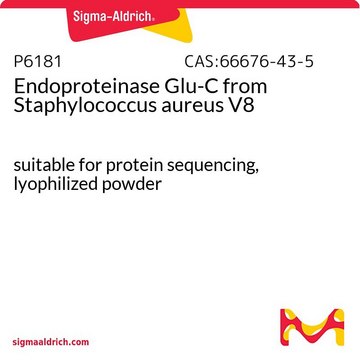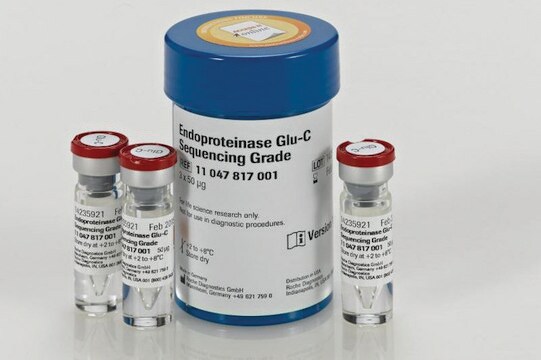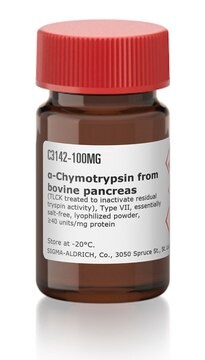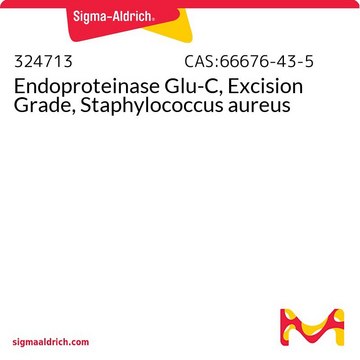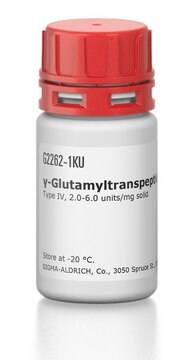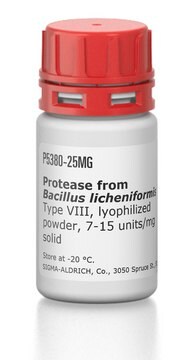P2922
Endoproteinase Glu-C from Staphylococcus aureus V8
Type XVII-B, lyophilized powder, 500-1,000 units/mg solid
Synonym(s):
V8 Protease
Sign Into View Organizational & Contract Pricing
All Photos(1)
About This Item
CAS Number:
MDL number:
UNSPSC Code:
12352204
eCl@ss:
32160410
NACRES:
NA.54
Recommended Products
type
Type XVII-B
Quality Level
form
lyophilized powder
specific activity
500-1,000 units/mg solid
mol wt
29 kDa
purified by
chromatography
shipped in
wet ice
storage temp.
−20°C
Gene Information
Staphylococcus aureus subsp. aureus MW2 ... sspA(1003044)
Looking for similar products? Visit Product Comparison Guide
Application
Endoproteinase Glu-C from Staphylococcus aureus strain V8 is a serine protease used for selective cleavage of proteins for amino acid sequence determination or peptide mapping . Product P2922 has been used to linearize cyclic peptides in C. ternatea leaf extract.
Endoproteinase Glu-C from Staphylococcus aureus V8 has been used to digest reduced and alkylated cyclotides to produce linearized fragments.
It is used for selective cleavage of proteins for amino acid sequence determination or peptide mapping.
Biochem/physiol Actions
Staphylococcus strain V8 protease specifically cleaves peptide bonds on the carboxyl side of aspartic and glutamic acid residues when used in phosphate buffer. When used in ammonium bicarbonate buffer or ammonium acetate buffer cleavage is restricted to the carboxyl side of glutamic acid residues only. The enzyme exhibits maximal activity from pH 4.0 to 7.8. If hemoglobin is used as the substrate, maximal activity is at pH 4.0. The maximal activity is at pH of 7.8 when casein is the substrate.
Unit Definition
One unit will hydrolyze 1 μmole of N-t-Boc-L-glutamic acid α-phenyl ester per min at pH 7.8 at 37 °C. One unit is equivalent to ~0.004 casein digestion unit.
Signal Word
Danger
Hazard Statements
Precautionary Statements
Hazard Classifications
Resp. Sens. 1 - Skin Sens. 1
Storage Class Code
11 - Combustible Solids
WGK
WGK 3
Personal Protective Equipment
dust mask type N95 (US), Eyeshields, Gloves
Choose from one of the most recent versions:
Already Own This Product?
Find documentation for the products that you have recently purchased in the Document Library.
Customers Also Viewed
From the Cover: Discovery of an unusual biosynthetic origin for circular proteins in legumes
Aaron G. Poth, Michelle L. Colgrave, et al.
Proceedings of the National Academy of Sciences of the USA, 108 (2011)
Shanshan Liu et al.
Amino acids, 48(4), 1059-1067 (2016-01-11)
Common yet often overlooked, deamidation of peptidyl asparagine (Asn or N) generates aspartic acid (Asp or D) or isoaspartic acid (isoAsp or isoD). Being a spontaneous, non-enzymatic protein post-translational modification, deamidation artifact can be easily introduced during sample preparation, especially
Andrew Michael Frey et al.
Cell reports, 35(1), 108930-108930 (2021-04-08)
Staphylococcus aureus possesses ten extracellular proteases with mostly unknown targets in the human proteome. To assist with bacterial protease target discovery, we have applied and compared two N-terminomics methods to investigate cleavage of human serum proteins by S. aureus V8 protease
Feliciano Priego-Capote et al.
Methods in molecular biology (Clifton, N.J.), 728, 219-232 (2011-04-07)
Glucose is the predominant source of energy in cells. However, a chronic high glucose exposure of proteins modifies a number of biological pathways, known as glucotoxicity. Several studies have suggested that this impaired protein function is associated in part to
Chengjian Tu et al.
Analytical chemistry, 83(12), 4802-4813 (2011-04-16)
The plasma proteome holds enormous clinical potential, yet an in-depth analysis of the plasma proteome remains a daunting challenge due to its high complexity and the extremely wide dynamic range in protein concentrations. Furthermore, existing antibody-based approaches for depleting high-abundance
Related Content
Enzymatic Assay of Endoproteinase Glu-C (EC 3.4.21.19)
Our team of scientists has experience in all areas of research including Life Science, Material Science, Chemical Synthesis, Chromatography, Analytical and many others.
Contact Technical Service